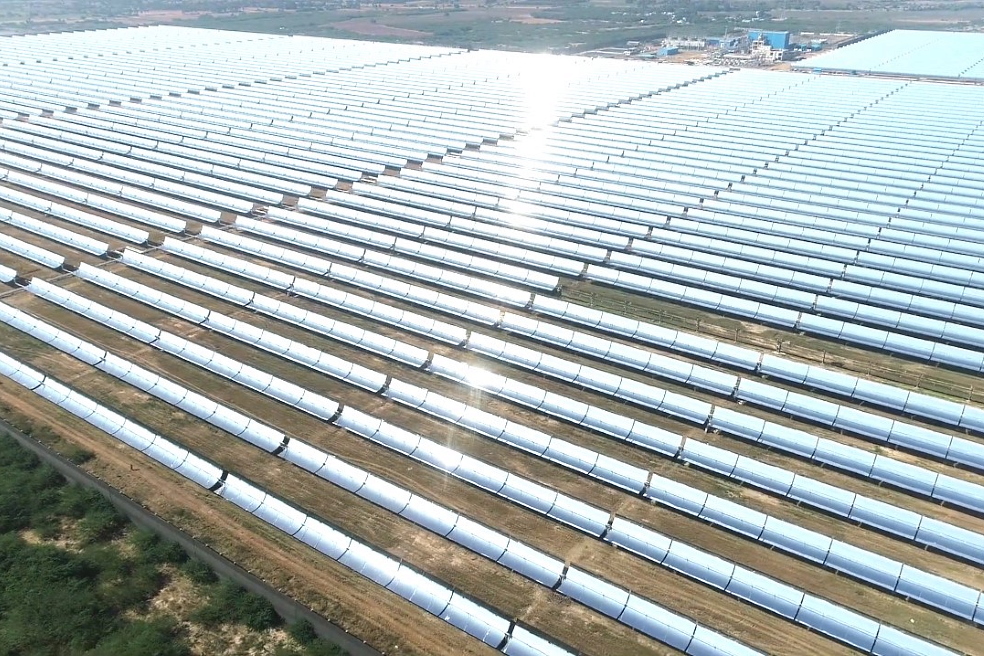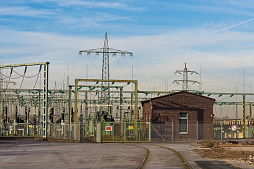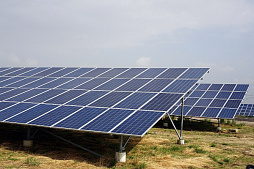Engineering, financing and construction of solar thermal (STPP) power plants
GCAM Investment Group offers:
• Investment financing from €50 million and more
• Minimizing the contribution of the project promoter
• Investment loan term up to 20 years
• Loan guarantees
Commercial energy production using solar concentrators is becoming an energy priority for countries with high levels of solar insolation, including Spain, Morocco, UAE, USA, Mexico and others.
The construction of solar thermal power plants can be the key to balancing socio-economic development and environmental responsibility.
Thanks to government assistance in the form of high tariffs for electricity generated and tax deductions, STPPs have become profitable systems that guarantee an acceptable level of profitability for investors.
The international company GCAM (Spain) offers comprehensive services in the field of of financing, construction and modernization of STPPS, providing customized technical solutions to companies in many countries.
Our team, together with partners from Spain and other European countries, is also ready to offer you financing and construction of solar projects on favorable terms.
Types of solar thermal power plants
There are two main ways to use solar energy for commercial purposes - photovoltaic and solar thermal technology.The latter means the conversion of solar energy into thermal energy of a heat transfer fluid, which is used to generate electricity through the Rankine, Brayton or Stirling cycle, including delayed generation. The unique advantage of this technology is that HTF can "store" energy for a long time, providing more stable generation throughout the day.
Among the numerous technical solutions for solar concentrators, parabolic cylindrical concentrators for converting solar radiation into thermal energy are considered the most mature technology.
The rest of the technologies, which may have a promising future, are still considered largely experimental, so it is rather difficult to find funding for these projects. About ten solar thermal technologies have gone beyond research and have already become the basis for large STPPs with an installed capacity of up to several hundred megawatts.
Classification of modern solar thermal power plants:
• Solar concentrators with parabolic trough.
• Solar concentrators with parabolic trough and heat storage technology using inorganic salts.
• Solar thermal power plants with linear Fresnel concentrators.
• Tower solar concentrators with direct steam generation.
• Tower solar concentrators with salt-based heat storage technology.
• Parabolic dish concentrators equipped with a Stirling engine.
• Hybrid STPPs combined with a gas boiler for fossil fuels.
• Hybrid STPPs combined with a solid fuel boiler for biomass.
• Hybrid STPPs using a combined cycle.
A technology based on concentrating solar energy along a pipe with a heat-conducting fluid using long parabolic troughs has been actively studied in the United States since the 1980s.
Based on this principle, the giant SEGS (Solar Energy Generating System) was built in the Mojave Desert, California.
As a result of years of operation of SEGS, researchers have accumulated tens of thousands of hours of experience to bring parabolic concentrator technology to its current state. No other technology has been studied so well. This is one of the reasons why most investors choose to build a STPP of this type, despite the well-known disadvantages and dangers (for example, the use of HTF based on aromatic hydrocarbons).
In general, there are two large groups of solar concentrators.
The first group of installations concentrates solar thermal energy along the line, and the second directs the rays to one point, reaching a much higher local temperature.
The first group of STPPs uses parabolic trough concentrators or Fresnel mirrors. The second group of installations, which operates with high temperatures and regulates the direction of the beams along two axes at once, uses either the central tower or Stirling engines. In the most advanced installations, thermal energy can be stored in order to convert it into electricity at the right time.
There are also hybrid solar thermal power plants that simultaneously use solar energy with fossil fuels or biomass. These engineering solutions significantly expand the list of opportunities for investors.
STPPs with parabolic trough: equipment and technologies
The share of parabolic concentrators currently accounts for 80-90% of all constructed STPPs, which makes this technology the most studied, reliable, predictable and affordable.An example of a concentraing solar thermal power plant based on parabolic troughs is the advanced CSNP Royal Tech Urat 100MW (China), which was connected to the national grid in January 2020.
Numerous power plants of this type operate in Spain, the United States and other countries.
The principle of operation of such facilities is the sequential heating of the heat-transfer fluid pumped along a pipeline several hundred meters long. The HTF transports thermal energy captured by the mirrors. The heated liquid is then used to generate steam and drive the steam turbine group.
Heat transfer fluid cycle
The fluid used may be water, but the problems associated with evaporation at an intermediate point in the route have not been solved at this time.For this reason, the selection of other fluids that do not change state between the start and end point of the pipeline is preferred.
Synthetic organic heat transfer fluids show the greatest advantages of all possible fluids. Among them, the eutectic mixture of diphenyl oxide and biphenyl stands out. This mixture represents the best compromise between cost and performance, although it can be very difficult to handle.
The search for the optimal balance between cost and technical characteristics forces engineering companies to look for new solutions and original approaches in the design and construction of solar thermal power plants of this type.
Thus, much attention is paid today to improving environmental safety and ease of operation and maintenance of such facilities.
After passing through parabolic-concentric mirrors, the heat transfer fluid is heated to a temperature of about 380-390ºC. These are safe values as HTF components quickly decompose when heated above 400ºC. Decomposition of the hydrocarbon heat transfer fluid into heavy and volatile fractions disrupts the operation of the solar concentrator and creates serious safety problems.
Regardless of the operating mode of the parabolic concentrator, the system requires the supply of special equipment for high-quality HTF purification from any decomposition products. Typically, purification is carried out using sequential filtration and distillation.
Solar collector field
A solar collector field, also called a solar field, is an area of up to two hectares for every megawatt of installed capacity where parabolic mirrors are installed.The construction of a STPP with an installed capacity of 100 MW may require approximately 200 hectares of land to house the concentrators, excluding the area for installing auxiliary equipment.
The collector modules must be ideally shaped and sized to maximize the concentration of solar radiation on the heat transfer fluid tube. The modules consist of numerous mirrors, an absorption tube and metal supports, which fix the entire structure in the most favorable position.
The modules are arranged in groups that move together so that the sun's rays always fall at an angle of about 90 degrees. Several collectors are connected in series, forming standard circuits (loops).
A large STPP can consist of several hundreds of such independent circuits, connected into a single power system.

Steam generator system
The heat absorbed by the heating medium is transferred to the water circuit to generate steam.This water, which has been pumped in a multistage centrifugal pump to a pressure of 50 to 100 bar, is vaporized and heated to about 380°C, while the HTF is cooled and prepared for reuse.
The cooled HTF returns to the solar field to continue transporting the energy captured by the parabolic concentrators. The equipment that is responsible for the heat exchange between the heat transfer fluid and the steam-water cycle is a large heat exchanger with a heat-insulating shell and numerous tubes inside it.
The engineering design and supply of steam generators for solar thermal power plants is a challenging practical task as engineers need to consider multiple risks and optimize equipment maintenance. Currently, each element of a STPP requires specialized maintenance and repair teams, which is associated with additional costs.
For this reason, professional equipment design is critical to the success of the entire project.
Steam turbine
The steam turbine is one of the key elements of any power plant that converts heat energy from steam into electricity. STPP is no exception.The superheated steam is sent to a steam turbine, where the next energy conversion takes place. The energy contained in the high pressure steam is converted into mechanical energy of the rotating turbine shaft. In this case, gas turbines cannot be used, given the low steam temperature (380ºC). The energy conversion efficiency ranges from 30% to 45%, depending on the load (higher performance is achieved at higher load) and peaks at 100% power.
The correct choice of a steam turbine at the stage of engineering design of a STPP plays a critical role, since each facility is built taking into account well-defined operating conditions, load, etc.
Steam condenser
The steam leaving the turbine is useless, unable to perform mechanical work.Its temperature can be less than 50-60ºC and the pressure is below atmospheric. In essence, the exhaust steam leaving the turbine is a stream of clean demineralized water that can be condensed and returned to the cycle.
Steam condensers for solar thermal power plants perform the following tasks:
• Waste steam is recovered for reuse of processing water.
• The condenser creates a low pressure, which increases the performance of the turbine.
In order to ensure the condensation of the exhaust vapor, it is necessary to add a liquid of low temperature or cold air to carry out heat exchange.
It should be remembered, however, that evaporation and condensation processes require a significant inflow of water.
When using water, steam condensers of powerful STPPs can consume from several hundred thousand to several million cubic meters of water per year. Therefore, the construction of such facilities away from natural water sources is impractical.
When constructing solar thermal power plants in dry areas, engineers use air cooling, in which the heat from the waste steam is transferred directly to the surrounding air. This is a less efficient and more expensive method, so it is only used when there are no other alternatives.
Generator and electrical substation
In the last stage of the cycle, the mechanical energy of the rotating shaft of the steam turbine is converted into electrical energy.This conversion is carried out using an alternator that is considered efficient and reliable electrical equipment.
The generated electricity is transmitted to the power grid via high-voltage transmission lines. These lines can be overground or underground.
Connecting a power plant from the power grid requires the construction and installation of a number of special elements:
• Transformer substation for voltage increase. It is important to take into account that generation is carried out at the most favorable voltage for the generator, and energy is transported at a high voltage that minimizes losses.
• Electrical protection system to ensure that the alternator and the entire electrical grid are maintained in proper conditions for stable operation.
• Control equipment that informs electrical protection systems about voltage, current and other parameters in real time.
GCAM finances electrical substations around the world.
Together with our partners, we have implemented many large projects in order to use this invaluable experience for your business.
Supplies of equipment for STPPs include selection, ordering, delivery and professional installation of generators, transformers, steam turbines, pipeline elements, HTF purification systems and other equipment.
Solar thermal power plants with a central receiver
Concentrating solar thermal power plants (CSPs) with a central receiver are made up of a series of large mirrors located around a tower, called heliostats.Each of the heliostats is equipped with an independent motor, thanks to which the reflected sunlight is concentrated at a certain point at the top of the tower at any time of the day.
The central receiver (solar tower) is responsible for converting concentrated solar radiation into heat, transferring it to a coolant, which can be air, water or inorganic salts. This medium can be used directly to convert water to steam and also to increase the performance of an integrated turbine by heating the intake air before entering the combustion chamber.
If the heat transfer fluid is water, central receiving units heat and vaporize the previously introduced fluid to produce steam at a specified pressure and temperature. This steam is then expanded in a steam turbine, following the general principles of any thermal power plant.

When the power plant is operating normally, inorganic salts are stored at around 290ºC in a large insulated tank.
A vertical centrifugal pump moves the salts from the reservoir to a receiver located at the top of the tower.
The heat transfer fluid, driven by the pumps, moves from the salt reservoir to a receiver at the top of the tower, where the temperature rises to about 560-600ºC.
The liquid is stored there until it is used to generate steam.
This technology allows CSPs to provide a relatively stable generation of electricity throughout the day, regardless of the intensity of sunlight.
Heliostats
Solar energy is captured by flat mirrors mounted on a movable structure.The system formed by mirrors, metal supports and their orientation systems is called a heliostat.
The function of the heliostat is to reflect sunlight, directing it to a receiving point on the central tower.
These mirrors have a surface reflectance of approximately 95%. In the small area occupied by the receiver, approximately 98% of the received radiation can be concentrated. When designing a CSP, it is important to choose the right supporting structure that can withstand the weight of the motor and mirrors, providing unprecedented reliability under wind loads.
Central receiver (tower)
One of the key components of solar thermal power plants is the hollow box located at the top of the tower.Due to the extremely high temperature and gradients closely related to the characteristics of the thermodynamic cycle, current research is mainly focused on the choice of materials and optimal location of the receiver.
The central receiver is responsible for converting solar energy into thermal energy.
It uses a series of tubes cooled by a liquid heat transfer medium into which some of the absorbed energy will be transferred. The tubes are usually made of stainless steel, and on the outside they have a selective coating that can absorb a significant part of the radiation in the visible and ultraviolet spectrum and emit minimal radiation in the infrared spectrum.
Benefits of central tower CSPs
The advantages of tower CSPs are the high flexibility, controllability and reliability of such installations.Among the advantages they offer over other solar technologies are the following:
• The use of the same heat carrier for energy generation and storage, which simplifies the system and improves the economic performance of the facility.
• High temperature of the heating medium compared to alternative technologies, which contributes to a increase in the efficiency of the steam-water cycle.
• Heat transfer fluid (molten salts) circulates through a well-defined area with higher efficiency compared to parabolic systems.
• HTF pipelines can be drained by gravity when the unit is not running, without the need to install additional pumping equipment.
A prime example of a central tower CSP is the Noor Ouarzazate CSP power plant, which has been under construction in Morocco since 2013. It is considered the largest power plant of this type on the planet, which was designed for the extreme conditions of the desert.
Solar thermal power plants for energy storage
One of the major problems of renewable energy, which uses methods that are highly dependent on weather conditions, is the difficulty of generating energy during periods of peak consumption.Generation is carried out under favorable natural conditions, but not at the peak of consumption.
Once electrical energy enters the grid, it must be consumed immediately. Since electricity is extremely expensive to store, production and consumption should ideally coincide in time.
This problem could be solved by generating electricity under favorable conditions and consuming it when needed. This means building a "storage" of energy in one form or another.
Since the storage of electrical energy on a large scale presents a number of problems that science has not yet solved, other types of energy storage have traditionally been used using, for example, pressure or temperature differences.
So, pumped storage power plants are based on storing dammed water in order to drain reservoirs and use water at the right time.

Thermal energy storage technologies for solar energy sector
Solar thermal power plants use different storage options, but energy is always stored in the form of heat for further electricity generation.While other methods are being explored, energy storage using molten inorganic salts is a technology that has been successfully tested in existing STPPs.
Table: some technologies for storing thermal energy.
| Technology | Short description |
| Storage of hot heat transfer fluid | This technology has been successfully tested at the US SEGS I power plant with a large reservoir that stored HTF from a solar field. After a massive fire that destroyed the facility, it was found that storing the flammable substance at high temperatures was impractical. In addition, the cost of the heating medium is much higher than that of inorganic salts. |
| Thermal energy storage in hot concrete | A hot liquid can heat a large mass of hardened concrete through a piping system designed for this purpose. If necessary, cold liquid, water, steam or HTF are fed through the same channels so that the heat energy stored in the concrete is transferred to the system. |
| Heat storage using solidification of inorganic salts | An important advantage of the technology is that the salt does not need to be pumped continuously through the pipeline. This reduces operating costs. The amount of salt required to store energy is relatively small. |
| Energy storage in the form of molten salts | Some facilities are implementing energy storage technology using molten salts in a single reservoir, so that cold and hot salts are separated due to their density difference. |
Our engineers use innovative technologies and materials that minimize heat loss and ensure efficient energy transfer at all stages of the process.
Hybrid solar-fossil fuel power generation
Today it is extremely difficult to make reliable weather forecasts and predict the generation of electricity from a solar thermal power plant.Since the beginning of construction of the first SEGS power plants in California, the possibility of adding an auxiliary fossil fuel boiler to the solar system has been investigated.
It is difficult to store electrical energy, so energy production and consumption must coincide in time. Otherwise, there will be certain imbalances in the power grid, which can lead to power outages for enterprises and entire regions.
While some experts believe that solar thermal power plants must have a heat storage system, in practice it is too expensive for a business.
The possibility of integrating an auxiliary boiler that runs on natural gas or biomass is provided for in the current standards in Spain and several other countries. That is, it is assumed that the STPP should be independent of natural conditions. Moreover, the boilers provide the necessary heat to prevent freezing of the heat transfer fluid, which is about + 12ºC.
Advantages of solar thermal-biomass hybridization
Solar thermal power plants without equipment for heat storage and without an auxiliary boiler on natural gas can operate from 2000 to 3000 equivalent hours annually, that is, about 60-70% of the time, these expensive installations are idle.The multimillion-dollar investment is idle, although there are viable ways to generate electricity from other sources. Energy facilities in areas with developed agriculture can use biomass as fuel.
Equipping STPP with a biomass boiler is certainly an attractive opportunity for investors in Southern Europe and other parts of the world.
Advantages of combined cycle hybridization
Solar thermal power plants in many cases operate using the well-known Rankine heat cycle.Of course, once the radiation has been converted into potential energy of hot steam, it is easy to mix it with steam generated from additional sources and jointly drive the turbine.
Hybrid power plants capable of mixing steam generated from solar collectors and from a gas turbine waste heat boiler are called ISCC (Integrated Solar Combined Cycle) power plants.
Fossil fuels have many disadvantages, but ISCC has two obvious benefits. This is a low cost of electricity generation and smooth power regulation to match the current load.
Our services include financing and lending for solar thermal power projects.
Contact our representatives to find out about our services.




















